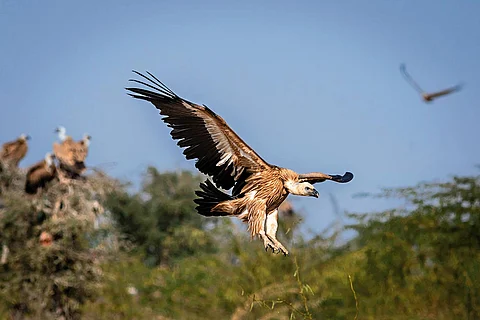
- Destinations
- Experiences
- Stay
- What's new
- Celebrating People
- Responsible Tourism
- CampaignsCampaigns
- SubscribeSubscribe
- Buy Now

When was the last time you saw a vulture soaring high in the sky? I remember a winged creature soaring past the chhatris of Orchha and alighting on one of its ledges, a huddled shape with a long, thin neck and bald head that, when captured on camera, could not do justice to the beauty of its real-life form. Initially confused about whether it was, in fact, a vulture, I asked around, and after some back-and-forth, everyone settled on it being the iconic bird of prey. That was perhaps my first and last memory of seeing a vulture in the flesh.
But this story is not about me, but rather about a conservationist who has given his life to protecting one of India’s most threatened birds—albeit one with a PR problem.
Dr Sachin Ranade is an ornithologist at the Vulture Conservation Breeding Centre (VCBC) in Rani, Assam. He works on captive breeding vulture populations nationwide and conducts scientific research on wild vultures’ population and habitat. Of the nine vulture species that live in India, Ranade is focused on reviving three of them: the white-rumped vulture, the long-billed vulture, and the slender-billed vulture. According to the International Union for Conservation of Nature (IUCN), all of these species are critically endangered.
His work is bearing fruit. The first successful hatching of the white-rumped and long-billed vultures occurred under Ranade’s watch at the VCBC in Pinjore, Haryana, in 2007-8, followed by the hatching of a slender-billed vulture in Assam a year later. So far, he has released 10 captive long-billed vultures and 74 captive white-rumped ones back into the landscape. VCBC outposts for conserving Gyps vultures have since sprung up in West Bengal and Madhya Pradesh, too.
While Ranade’s work occupies his whole day, and sometimes nights, he didn’t start out looking after vultures and raptors during his nearly three-decade-long career.
Most people today recognise the importance of vultures and what ails them. A laundry list of their attributes includes being “nature’s best cleaning crew,” as Ranade puts it, thanks to their role in preying on pests and livestock carcasses, reducing contagious diseases due to their strong stomach acid, which can digest all manner of viruses, bacteria, and fungi; and surprising role in preventing rabies, as their absence leads to more flies, rats, and dogs picking off carcasses and spreading the disease.
It’s not a stretch to say that their presence has shaped human progress, Ranade says. “When we were hunter-gatherers, we shared our food with vultures. In the last few thousand years, we started to keep livestock,” he says.
“When mortalities occurred, the carcasses were thrown out of human settlements, so vultures fed on them and controlled the possible outbreak of diseases. That’s why very few pandemics were noted in our civilisation. Our forefathers knew their value; that’s why the character of Jatayu in the epic ‘Ramayana’ was created.”
But since the 1990s, India has lost over 99 per cent of its vulture population, representing the sharpest decline of any animal in that period. A major factor has been the widespread use of drugs such as diclofenac, a nonsteroidal anti-inflammatory drug (NSAID) commonly given to livestock. The residue of this drug remains in an animal’s liver and kidney after they have died, so when vultures feed on them, their kidney suffers permanent damage, and they die a painful death.
In 2006, India banned diclofenac for veterinary use, but it’s still used illegally thanks to a lack of enforcement. The same situation persists for newly banned drugs like diclofenac, ketoprofen, and nimesulide. According to Ranade, the use of poison bait in Assam, which is used to kill feral dogs and leopards but consequently kills vultures, too, electrocution due to overhead wires, and the loss of nesting trees also threaten the vulnerable species.
Ranade recounts what it’s like to see vultures dying from poison bait. “I rush to save the surviving vultures and collect samples from the dead for investigation. It's heartbreaking—five years to raise one in captivity, yet a single careless act can kill many in moments.”
How do you pick yourself up after dealing with so much loss and suffering? Ranade says he distracts himself by engaging with other projects, which help to inspire him with creative solutions to sticky problems. He doesn’t take Sundays or holidays off, but his love for the birds makes his eyes sparkle even today.
“After years of loss, the first successful egg hatching in our breeding programme felt like nature’s blessing. Releasing the birds in 2019 was emotional—20 years of hope, tension, and science culminating in one powerful moment. Only later, away from the formalities, did the weight of it all bring tears,” he says.
Ranade’s all-consuming passion means he’s constantly on the move, whether carrying out fieldwork, rescuing vultures, or talking to government officials and community stakeholders. He knows that time is costlier than anything else on Earth in terms of reviving vulture species. But, of course, he won’t ever give up.
“I feel blessed with the species I am working with. The birds are part of my life and I am an equally important part of their life—that’s the most valuable feeling.”
